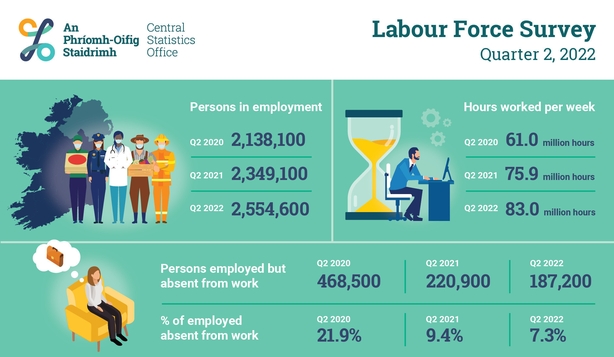The employment rate in the second quarter of the year was 73.5%, according to new figures from the Central Statistics Office.
It is the highest rate since the current series of records began in 1998.
The latest Labour Force Survey from the CSO shows that the number of people in employment increased by 8.7% to 2,554,600 in the year to the second quarter of 2022.
The number of absences from work during the reference week was 187,200, compared to a peak of 468,500 absences recorded in the second quarter of 2020 during the Covid-19 pandemic.
There were 119,900 people classified as unemployed in the second quarter of 2022 with an associated unemployment rate of 4.5%.
"Employment increased in the year to Q2 2022 across most economic sectors with the largest increase in the Accommodation & Food Service sector," said Sam Scriven, a CSO statistician.
"However, employment in this sector at 168,200 remains below the Q2 2019 level of 180,800," he added.
The survey shows that there were 4.8 million hours worked per week in the Accommodation & Food Services sector.
While this an increase from 2020, it still remains below the pre-pandemic figure of 5.4 million hours worked.

Today's CSO figures also show that the number of people employed in construction increased by 40,000, or 31.4%, in the year to the second quarter of 2022.
There was also an increase in employment in the arts, entertainment and recreation sector.
There were small annual decreases in the number of people employed in the agriculture, forestry and fishing sector; financial, insurance and real estate sector; and in public administration and defence.
Tánaiste and Minister for Enterprise, Trade and Employment Leo Varadkar said that more people are working in Ireland than ever before and unemployment is at a 21-year low.
"That is incredible given where we were a couple of years ago, with the pandemic and Brexit, and the current challenges we are now facing with Putin's war and inflation. It is a testament to the hard work and remarkable resilience of Irish enterprise," Mr Varadkar said in a statement.
He also said he was particularly pleased to see that jobs have grown in all parts of the country, with a significant increase outside of Dublin.
"The bounce back in the hospitality sector is another highlight. Although not yet back to where it once was, employment in the Accommodation and Food Service sector increased by 40% in the past 12 months. The last two years have been especially challenging for businesses and workers in that sector, but it appears our strong policy interventions during the pandemic - effectively keeping workers attached to employment - has minimised any long-term scarring," he stated.
More people working in Ireland than ever. Unemployment at 21 year low. Will not take it for granted. Understand some businesses still struggling, will continue to help & see what more we can do to protect and create jobs and businesses, improve wages and protections https://t.co/CFs6a93snp
— Leo Varadkar (@LeoVaradkar) August 25, 2022
"I know these results don't tell the lived experience for all businesses and that some are still really struggling, especially with increased costs, and we will continue to help, with our existing schemes, but also by introducing new measures in the upcoming Budget to help with what will be a difficult winter ahead," the Tánaiste said.
Minister for Finance Paschal Donohoe said today's CSO figures show the continued recovery in the labour market, consistent with the income tax data that we have seen over the summer months.
"Encouragingly, the recovery is being led by strong participation from both youth and female workers, with more opportunities than ever opening to persons wanting to contribute to Ireland’s economy," Mr Donohoe said.
But he added that looking ahead, indicators suggest a moderation of economic activity and this could slow the pace of employment growth in the second half of the year and into next year.
"My department will publish an updated analysis and detailed forecasts in the coming weeks as part of Budget 2023," he added.







